Mass Spectrometry Forum: Ion Lenses
Columnist Kenneth L. Busch looks at the impact ion lenses can have on the performance of the mass spectrometer.

Efficient creation, transport, containment, and detection of ions are issues at the core of mass spectrometry. Improvement in any of these areas leads to improved overall performance of the mass spectrometer. As in most sequences of operations, maximum performance benefits usually are obtained with improvements at the beginning of the sequence. As a result, improvements in the efficiency of ionization often result in large rewards in instrument sensitivity. As electrospray ionization (ESI) progressed through its first few generations of source design, the instrument performance increases were substantial. Once the ions are created, it is the role of ion lenses to extract ions from the source efficiently and focus them as they pass through the mass spectrometer. As one might expect, ion lenses of diverse designs have evolved to match ionization sources of different types. Lens designs also vary with the masses, charges, and velocities of the ions to be focused. Advanced texts and computer programs are available for a broad overview (1—4). The tutorial of Wollnick (5), the review by Burgoyne and Hieftje for mass spectrographs (6), and the detailed study of ion deceleration lenses by O'Connor and colleagues (7) are especially useful for mass spectrometrists interested in instrument design.
In "beam" mass spectrometers, ions are first created in the ionization source, then moved elsewhere in the instrument for sorting by mass (the mass analyzer), and are finally sent off to the detector. Thus, beam instruments physically transport either a continuous stream, or a series of packets of ions, through the components of the instrument, proceeding from ionization source through the mass analyzer to the detector. In contrast, "in time" instruments can store ions within a cell or a trap, but only after the ions are transported there from the separate ionization source. Mass analysis occurs as the instrument monitors the behavior of this trapped ion population with time. However, transport of ions out of the cell might still be required for ion detection. If the detection is done in situ, then the elements of the holding cell also function as ion lenses. The trapped ions never cease their movement, and scattering collisions with neutral molecules reduce the trapping efficiency.

Kenneth L. Busch
The set of coordinates used to chart ion movement within a mass spectrometer is shown in Figure 1, which shows that "x" usually is chosen to correspond to the direction of ion movement from the source toward the detector, and "y" and "z" represent the mutually orthogonal axes. In a magnetic sector instrument, "y" traditionally was set to be the axis orthogonal to the magnet pole faces; in Figure 1, this is set as the vertical axis from the point of view of the instrument operator. In a beam instrument, therefore, ions move along the x-axis from source to detector, motivated by the accelerating potential. Additionally, of course, the ion path can be curved (as through a magnet), or oscillating (as through a quadrupole mass filter), and therefore, the ions move in both directions on the y- and z-axes. In a reflecting time-of-flight mass spectrometer, the ion path turns back on itself, and ions therefore move in both +x and –x directions to reach the detector. The goal of ion lenses is to maximize transmission and shape the ion beam in (x, y, and z) as it passes from the source to the detector. Ion lenses can include both potential or magnetic elements, reflecting the fact that moving ions will respond with a change in direction to either an applied potential field or an applied magnetic field, following the fundamental laws of physics.
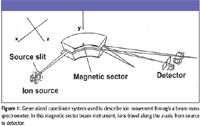
Figure 1
We concentrate here exclusively on potential-driven lenses. Mass spectrometers usually contain multiple sets of ion lenses, and more complex lens structures often are assembled from combinations of simpler elements. In this overview, we will describe four simple types of ion lenses, starting with source lenses, which act primarily to extract ions from the ionization source. Source lenses influence the divergence of an ion beam in the "z" or "y" directions, and pften are designated by that coordinate name (z-lens or y-lens) when they are used immediately after the ionization source. Next, we will describe the chicane lens, which acts to remove the line-of-sight from an ion beam. Removal of a line-of-sight is often important in the reduction of background signals. We'll provide a short description of the einzel lens, commonly used to restrict the energy width of an ion beam. Finally, we will describe a multicomponent ion funnel used to transport ions from a relatively high-pressure electrospray ionization (ESI) source into the lower-pressure mass analyzer of an instrument.
The potentials applied to potential lenses can be static or dynamic, or even a combination of both. Static operation means that the device potentials are fixed; a dynamic mode means that the applied potentials can vary with time. One reason to adopt a dynamic mode of operation is to maintain lens efficiency across the full range of ion masses in the beam that we wish to focus. For example, in an inductively coupled plasma–mass spectrometry (ICP-MS) system, the analytical range of atomic ion masses varies over about 1.3 orders of magnitude. Therefore, a dynamic ion lens maximizes ion transmission in the full ion mass range. An organic mass spectrometer deals with an even broader mass range (encompassing about 2.5 orders of magnitude), and the need for dynamic operation might be even more pronounced. Ionization sources might also produce multiply charged ions, and the ion lens system can even be designed and operated to discriminate between various charge states. Finally, remember that there is a fundamental limit to how tightly an ion beam can be focused, as the Coulombic repulsion between same-charged ions will always tend to cause spatial divergence in the ion beam.
Focusing Lens
Focusing lenses can be placed anywhere along the ion path in a beam mass spectrometer. They are commonly placed immediately after the ion source (and are therefore termed source lenses), but also are sited between components in a multicomponent instrument and immediately before the detection system. As source lenses, their primary purpose is to aid in the extraction of ions from the source and to focus and shape the ion beam as it passes into the mass analyzer. The repeller fitted to most electron ionization (EI) and chemical ionization (CI) sources is a crude ion lens. A flat plate repeller can be used to nudge the ions toward the mass analyzer through the ion source exit aperture. As Park and Ahn (8) describe, the repeller can be shaped to direct the ions out of the source more efficiently. Traces for equipotential lines in even a simple EI source can be complicated, with field penetration through each and every conductance aperture. The electrons from the source filament in an EI source can be made to spiral in a constrained area with the use of a source magnet. But gas-phase sample molecules ionized by those electrons within that volume maintain their initial distribution of velocities, and the ions depart from that volume in all directions. A thorough understanding of the potential gradients inside the source underlies good lens design.
The repeller is usually only the first stage in a series of ion lenses that work together to extract the ions from the source, accelerate them to a potential commensurate with the operation of the mass analyzer, and shape the ion beam. For example, a quadrupole mass filter will accept ions of relatively low kinetic energy (up to 50 V, for example, depending upon the quadrupole size and electronics). A circular ion beam shape created through circular conductance and lens apertures matches the acceptance function of the quadrupole (although ions that proceed down the exact center of a quadrupole rod structure are not mass-analyzed). Therefore, the ion lens in such a quadrupole-based system usually consists of a series of plates set orthogonal to the x-axis, with central circular apertures, and operating focus potentials of ± tens of volts. More extensive shaping of the ion beam usually is not needed, and the assumption is often made that the apertures are illuminated uniformly by the ion beam.
If the mass analyzer consists of electric or magnetic sectors, the ion beam is accelerated through the source potential to a higher velocity than in a quadrupole-based instrument, and the ion beam usually must be transformed to a rectangular profile. The physical slits often found along the ion path of a sector instrument accomplish the beam shaping by acting as stops for the ions with off-axis directions. Of course, discarding ions lowers instrument performance, and y-lenses and z-lenses (and other forms of beam-shaping lenses) usually are used first used to "squash" the ion beam into a proper profile shape.
In the simplest configuration, a pair of plates with faces orthogonal to the y- and the z-axes can be installed. The plates can be paired electrically, or can be decoupled, and also can be linked dynamically to the mass-analyzing function of the instrument. As the need to shape the ion beam becomes more stringent, the plates themselves can be formed into complex shapes, or a series of multiple smaller plates can be used. Simple focusing plates can be joined with an einzel lens or can be conjoined into an ion zoom lens. An electrostatic quadrupole ion guide can be added. All such permutations and combinations are designed to preserve ion transmission across the mass range of interest. Because the source lens is early in the sequence, improvement in ion transmission into the mass analyzer generates considerable benefits in overall instrument performance. Therefore, the variety of patented configurations and devices for all types of mass spectrometers is considerable. There is always a balance to be achieved in ion transmission that balances ion lens complexity with such factors as ion path length, operating pressures along that length, and ease of instrument operations. For example, those of us who have reached a certain age might recall a lengthy tuning process to coax high mass-resolving powers from a sector instrument while maintaining the maximum possible sensitivity.
Chicane Lens
Many ionization sources produce not only ions, but also neutral species and photons. If there is a line-of-sight from source to detector, the arrival of fast neutral species and photons at the detector can contribute to a background signal that limits instrument performance. The background signal is of course independent of any mass analysis that is completed, and is instead dependent upon the operation of the ionization source.
Several approaches to reduce this noise have been developed. The detector can be placed off-axis, and a lens system used to deflect a mass-analyzed ion beam to the detector. A "bent" quadrupole removes the line-of-sight from source to detector. In an ICP-MS instrument, the flux of photons from the source can contribute to a significant background noise at very high sensitivity operation. A photon stop (literally a shadowing barrier) can be used to block photons from the direct line of sight, but such a barrier also blocks the ions following the same path.
Iizuka and Hirata (9) described the use of a chicane lens (Figure 2) fitted to the front end of an ICP-MS system. The bend in the ion path is accomplished with a combination of simple lens elements and results in a 3–4× increase in the measured sensitivity of the instrument. Chicane lenses of the same general design have also been used in organic mass spectrometers. For example, Boyd and colleagues (10) incorporate a chicane lens into a hybrid instrument, and the central stop of the chicane lens is an important component of the neutralization reionization mass spectrometer described by Turecek and colleagues (11).
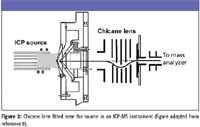
Figure 2
Einzel Lens
Many websites cite only the early work of Aberth and colleagues in 1974 (12) as describing the design and operation of an einzel lens, but in fact the characterization dates back to Rangel in 1942 (13) and Adams and Read in 1972 (14). Aberth's work was significant in describing the use of the einzel lens in a mass spectrometer used for chemical analysis. A simplistic diagram of a three-element ion lens is given in Figure 3, conveying the essential elements of operation, which are: the first and third elements of the lens are coupled, and the central element is held at a different potential; and a focal point for the ion beam moving along the x-axis is achieved at some point after the lens. If the ions are decelerated to a very low kinetic energy at the central electrode, the einzel lens can be operated in such a way that it becomes an ion energy selector. The details for this operation are beyond this introduction, but we may revisit them in the future. The SIMION simulation for an einzel lens is found at: http://simion.com/examples/einzel.html
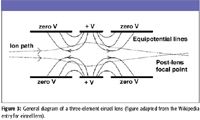
Figure 3
Ryba and Mains (15) described an einzel lens as part of an improved Mattauch–Herzog mass spectrometer. The performance evaluation for this lens using the computer code of the time can be compared with the capabilities of the modern SIMION program. Einzel lenses are also commonly used in sector–quadrupole mass spectrometers as part of the deceleration lens stack, as described by Suter and colleagues (16). Li and coworkers (17) have described the role of the einzel lens as part of the interface between an ion mobility spectrometer and a time-of-flight mass spectrometer. Miniature mass spectrometers require miniaturized lens systems, and an einzel lens can be micromachined to match the scale of the entire instrument. For example, Syms and colleagues (18) describe a micromachined einzel lens used in conjunction with a quadrupole electrostatic lens to couple an ion source to a mass analyzer in a miniaturized instrument.
Ion Funnels
While the issue of source lenses has been explored thoroughly during the development of the EI source over the past 60 years, and the CI source over the past 40 years, the source in both instances operates at reduced pressure relative to atmosphere, and the ion paths are not excessively scattered by collisions with neutral gas molecules. The typical EI source operates at 10–5 to 10–6 torr, and the CI source operates at about 1 torr. Conductance apertures limit the pressure within the mass analyzer, and the changes for operation of the source and focusing lenses for CI compared to EI usually were limited to increasing the absolute magnitude of the applied potentials. With ESI, the ionization occurs at atmospheric pressure. Not only does the conductance problem become more acute, but the lensing system requires special attention. An advantage of the ESI source is that the ions are formed anisotropically, with some initial velocity directed away from the tip of the sprayer.
At first, ESI sources were coupled with the usual and customary lens elements. But it soon became evident that new designs were needed. As an example, in 2001, Schneider and coworkers (19) discussed lenses that could work at atmospheric pressure and with a variety of sprayer positions. A two-to fourfold increase in the absolute level of the ion signal could be achieved with proper selection of the lens potentials. Interestingly, the authors report that the relative distributions of the multiply charged ions from the ESI source could be varied with different operation of the lens. This signature observation should alert ESI users to the influence of interfacial spray chemistry, along with bulk solution chemistry, on the detailed distribution of charged states in an ESI mass spectrum.
Maximum ionization efficiency in ESI usually occurs at flow rates different from those required in usual practice. Therefore, to maximize the creation of ions from an ESI source, multiple emitters have been used, creating ions in an array of initial positions, all at atmospheric pressure. The ion lens "problem" of collecting these ions and directing them efficiently to the mass analyzer is significant. Ibrahim and coworkers (20) describe the use of sequential ion funnels (Figure 4) to accomplish this task. A leading high-pressure ion funnel is followed by a "conventional" ion funnel with a conductance limiting aperture between them. The conventional ion funnel comprises 100 brass plates, each 0.5 mm thick and separated by 0.5-mm-thick PTFE sheets. The central aperture in each of these plates decreases in diameter for the series of plates along the x-axis. A 180° out-of-phase RF field is applied to adjacent electrodes to create an effective potential well that confines the ions while a DC gradient of 16 V/cm pushes the ions through the ion funnel.
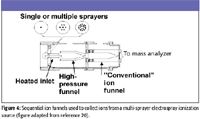
Figure 4
The importance of the ion lens system in a mass spectrometer often is underestimated, and the chance to explore and redesign within the modern generation of instruments is far too limited. While attention may be focused (pun intended) on applications, our understanding of ion optics as applied to mass spectrometry continues to be explored. Consider this brief synopsis of "ion optics"–related presentations available only on Monday at the 2009 annual meeting of the American Society for Mass Spectrometry in Philadelphia. Poster 211 (21) described curved radio-frequency ion guides. Poster 311 (22) explored the concept of "rim losses" in mass spectrometers. Poster 473 (23) described an interesting lens system on a mass spectrometer that could be tuned to offer some discrimination between singly and doubly charged ions. Given the underlying simplicity of the physics that governs ion motion, one might be tempted to think that approaches to efficient ion optics and ion lenses were issues relegated to the past. The conclusion that "everything useful has already been discovered" has proven the undoing of many a scientist.
Kenneth L. Busch never could properly remember out the right-hand rule, and it was not fun to watch him trying to do so during the final examination for Physics 201. In later years, his limerick "On the Quad Rods" was a daring investigative exposé of the origin of ion burn. That piquant rhyme cemented his reputation, one way or the other. He can be reached at wyvernassoc@yahoo.com
References
(1) E. Harting and F.H. Read, Electrostatic Lenses (Elsevier, New York, 1976).
(2) K.J. Hanszen and R. Lauer, "Electrostatic Lenses," in A. Septier (Ed.), Focusing of Charged Particles (Academic Press, New York, 1967).
(3) J. Orloff, Handbook of Charged Particle Optics (CRC Press, Boca Raton, Florida, 2008).
(4) The SIMION product web site is at http://simion.com.
(5) H. Wollnik, J. Mass Spectrom. 34, 991–1006 (1999).
(6) T.W. Burgoyne and G.M. Hieftje, Mass Spectrom. Rev. 15, 241–259 (1996).
(7) P.J. O'Connor, G.E. Leroi, and J. Allison, J. Am. Soc. Mass Spectrom. 2, 322–335 (1991).
(8) C.J. Park and J.R. Ahn, Rev. Sci. Instrum. 76, 044101.1–044101.5 (2005).
(9) T. Iizuka and T. Hirata, Geochemical Journal 38, 229–241 (2004).
(10) R.K. Boyd, E.W. Dyer, and R. Guevremont, Int. J. Mass Spectrom. Ion Proc. 88(2–3), 147–160 (1989).
(11) F. Turecek, M. Gu, and S.A. Shaffer, J. Am. Soc. Mass Spectrom. 3, 493–501 (1992).
(12) W.H. Aberth, R. Schnitzer, and F.C. Engesser, Rev. Sci. Instrum. 45, 1289–1290 (1974).
(13) E.G. Ramberg, J. Appl. Phys. 13, 582–594 (1942).
(14) A. Adams and F.H. Read, J. Phys. E. 5, 150–155 (1972).
(15) R.J. Ryba and G.J. Mains, Int. J. Mass Spectrom. Ion Phys. 42(3), 169–182 (1982).
(16) J.-F. Suter, R.M. Stepnowski, and U.P. Schlunegger, Rapid Commun. Mass Spectrom. 3(12), 417–419 (2005).
(17) F. Li, T. Horvath, H. Schmidt, S. Sielemann, and J.I. Baumbach, Int. J. Ion Mobility Spectrom. 5, 149–153 (2002).
(18) R.R.A. Syms, L. Michelutti, and M.M. Ahmad, Sens. Actuators, A 107, 285–295 (2003).
(19) B.P. Schneider, D.J. Douglas, and D.D.Y. Chen, Rapid Commun. Mass Spectrom. 15, 2168–2175 (2001).
(20) Y. Ibrahim, K. Tang, A.V. Tolmachev, A.A. Shvartsburg, and R.D. Smith, J. Am. Soc. Mass Spectrom. 17(9), 1299–1305 (2006).
(21) F. Muntean and U. Steiner, Presented at the 57th ASMS Conference on Mass Spectrometry and Allied Topics, Philadelphia, PA, May 31–June 4, 2009.
(22) R.C. Willoughby, E. Sheehan, and D. Fries, Presented at the 57th ASMS Conference on Mass Spectrometry and Allied Topics, Philadelphia, PA, May 31–June 4, 2009.
(23) J.E. Yves Leblanc, C. Hao, J.L. Campbell, and K.W.M. Siu, Presented at the 57th ASMS Conference on Mass Spectrometry and Allied Topics, Philadelphia, PA, May 31–June 4, 2009.
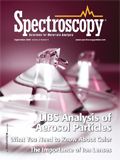
LIBS Illuminates the Hidden Health Risks of Indoor Welding and Soldering
April 23rd 2025A new dual-spectroscopy approach reveals real-time pollution threats in indoor workspaces. Chinese researchers have pioneered the use of laser-induced breakdown spectroscopy (LIBS) and aerosol mass spectrometry to uncover and monitor harmful heavy metal and dust emissions from soldering and welding in real-time. These complementary tools offer a fast, accurate means to evaluate air quality threats in industrial and indoor environments—where people spend most of their time.
NIR Spectroscopy Explored as Sustainable Approach to Detecting Bovine Mastitis
April 23rd 2025A new study published in Applied Food Research demonstrates that near-infrared spectroscopy (NIRS) can effectively detect subclinical bovine mastitis in milk, offering a fast, non-invasive method to guide targeted antibiotic treatment and support sustainable dairy practices.
Smarter Sensors, Cleaner Earth Using AI and IoT for Pollution Monitoring
April 22nd 2025A global research team has detailed how smart sensors, artificial intelligence (AI), machine learning, and Internet of Things (IoT) technologies are transforming the detection and management of environmental pollutants. Their comprehensive review highlights how spectroscopy and sensor networks are now key tools in real-time pollution tracking.